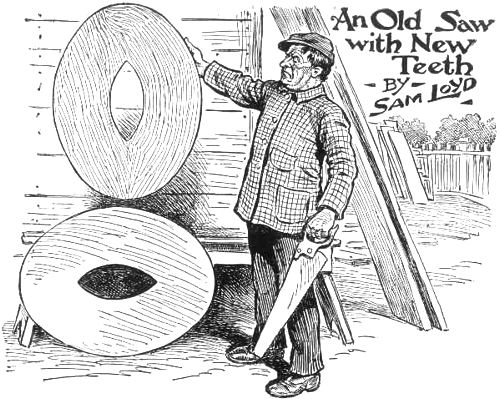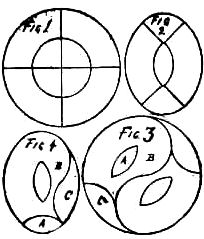



ALMOST EVERY COLLECTION or puzzles contains a certain problem wherein it is told how a joiner who had a circular board wished to convert it into two oval table tops, with holes in the centers as shown. The puzzle is to cut the circular piece into the fewest number of pieces which will form the two ovals, but as the shape o£ the ovals are not given, the puzzle is generally looked upon as too difficult and unsatisfactory.
By the modern plan, however, which is to reverse a problem and work it backwards, the terms may be turned around so as to make a presentable, up-to-date puzzle, and is given as an instructive lesson in puzzle building.
Divide the two oval rings into the fewest possible number of pieces which will fit together and form one circular pieceâ”like the top of a table without any hole in it.
Of course, you may follow the old style if you prefer it. Take a perfect circle and divide it into the fewest possible number of pieces which will fit together and form two oval rings as shown, but remember to put a strong accent, upon the âfewestâ number of pieces.
In the following diagram Fig. 1 shows the popular way of solving this old puzzle according to the puzzle books. This would divide each of the oval rings into four pieces, as shown in Fig. 2. According to our recently-discovered method, which introduces the Chinese Monad sign, as shown in Fig. 3, the feat can be performed with six pieces instead of eight.

2. A Good Catch on Sharpe.
Brown (to Sharpe, who prides himself on his spelling): âI bet I can give you a word you canât spell.â
Sharpe (scornfully); âI bet you can't.â
Brown: âVery well. How do you spell âneed.â meaning to need bread?â
Sharpe: âPoof! K-n-e-a-d, of course.â
Brown: âWrong.â
Sharpe: âWrong? Meaning to knead bread, you said, didnât you?â
Brown: âYes.â
Sharpe: âWell, itâs k-n-e-a-d, I tell you.â
Brown: âNot at all. You k-n-e-a-d dough, but you n-e-e-d bread. Itâs a simple word; sorry you couldn't spell it.â
3.
Why are ripe potatoes in the ground like thieves? Because they should be taken up.
What is that which everyone wishes, and yet wants to get rid of as soon as it is obtained? A good appetite.
When is an old lady like a trout? When she takes a fly that brings her to the bank.
What is it gives a cold, cures a cold, and pays the doctorâs bill? A draft.
Take away my first letter, I remain unchanged; take away my second letter, there is no apparent alteration in me; take away all my letters and I still continue unchanged? The postman!
Why is a new-born baby like a storm? Because it begins with a squall.
Mention the name of an object which has two heads, one tail, four legs on one side and two on the other? A lady on horseback.
Why is a four-quart jug like a ladyâs side-saddle? Because it holds a gall-on.
If you were kissing a young lady, what would be her opinion of newspapers? She wouldn't want any Spectators, nor Observers, but plenty of Times.
[Page 200]